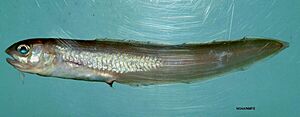Band cusk-eel facts for kids
Quick facts for kids Band cusk-eel |
|
|---|---|
 |
|
| Conservation status | |
| Scientific classification | |
| Synonyms | |
|
The band cusk-eel (Ophidion holbrookii) is a type of fish. It belongs to a family of fish called Ophidiidae. You can find it in the western part of the Atlantic Ocean. It lives from North Carolina in the USA, down to the northern Gulf of Mexico, and all the way to southeastern Brazil. However, it does not live near The Bahamas.
This fish lives in tropical waters near reefs, usually on the ocean floor. It can grow up to 30 cm (about 12 inches) long. Band cusk-eels usually live deeper than 18 meters (about 60 feet) below the surface. This species was first discovered near Key West, Florida, USA, in 1874. It was described by a scientist named Frederic Ward Putnam.
Contents
About the Band Cusk-Eel
Even though they are called "cusk-eels," these fish are not true eels. True eels do not have certain fins that cusk-eels do. Cusk-eels have special fins called ventral fins. These fins are forked and are located just below their mouth.
Like true eels, cusk-eels have a long, thin body. Their mouths are usually at the very front of their head. They also have many small, rough teeth.
Body Features
The band cusk-eel is a fairly small fish. But it has a complex skeleton. It has 20 ribs, which help it bend and move easily. It also has 66 to 69 bones along its spine, called vertebrae.
This type of cusk-eel is a dull tan color. It does not have scales on the top of its head. Its dorsal fin (on its back) and anal fin (on its belly) are connected to its tail fin. These fins are also lined with black. The body of the band cusk-eel is quite deep. Scientists count the number of rays in their fins to tell different species apart.
Special Body Parts
Many cusk-eel species have a hard swim bladder. This is an organ that helps them float. It can also act like an echo chamber to make sounds. Scientists have studied this in striped cusk-eels. They believe other cusk-eels, like the band cusk-eel, might use their swim bladder for sound too.
Studies show that cusk-eels have a special lateral line system. This system, along with muscles in their swim bladder and other head organs, helps them hear very well. It also helps them sense depth and vibrations in the water. This is useful for finding food and avoiding danger.
Differences Between Males and Females
Male and female band cusk-eels look very similar in color. However, there are some interesting differences in their bodies. Both males and females have a hard swim bladder. This suggests that females might also use it to make sounds.
Male band cusk-eels have a unique bone structure called a "rocker." All cusk-eels have a special first vertebra (a bone in the spine) that looks like a wing. But in males, there is an extra bone that floats freely. This bone curves along other vertebrae and connects to the swim bladder. Scientists call it a "rocker," but they are not sure what it does. Females do not have this rocker bone. Instead, they have two hollow bumps coming from their vertebrae.
Where Band Cusk-Eels Live
Cusk-eels usually live on the bottom of shallow waters. They find shelter in many places. This can include caves, cracks in rocks, or even inside other sea creatures. They also like to hide in burrows in the mud or sand. Sometimes, a single fish lives in a burrow, and sometimes groups of them do. Scientists are still working on a full map of where all band cusk-eels live.
How Band Cusk-Eels Behave
Not much is known about the behavior of cusk-eels in general. What we do know is often not specific to just one species. Many cusk-eels are known to live near or even inside other sea animals without harming them.
Most cusk-eels burrow into the sand or mud during the day. They might do this to save energy or to hide from predators. Videos show them burrowing tail-first. They back down into the soft sand or mud until they are completely covered. Male cusk-eels that can make sounds often make a loud, "jackhammer-like" noise. They do this to attract a mate. Band cusk-eels likely eat small invertebrates, such as shrimp or worms.
Reproduction and Life Cycle
Male band cusk-eels do not have special organs for mating. Because of this, their eggs are fertilized outside the body. The fertilized eggs stick together in jelly-like clumps. These clumps then float near the surface of the water.
Young band cusk-eels, called juveniles, are rarely seen. In one study, young cusk-eel larvae were found near the surface. They were traveling alone. Another study found that in some cases, young cusk-eels might live with other large invertebrates. They may or may not use these companions for food.
Conservation Status
The band cusk-eel is listed as "Least Concern" by the IUCN Red List of Threatened Species. This means that its population is stable, and it is not currently at risk of disappearing.
This fish is not usually caught for food. However, it is sometimes caught by accident by shrimp trawlers off the coast of Colombia. There, its meat is valued and sold as La perla.
Sources


